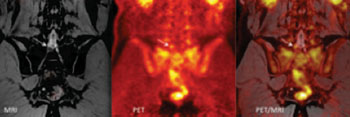Innovative Technique Promises New Inroads into the Diagnosis and Management of Pain
By MedImaging International staff writers
Posted on 19 Apr 2015
Magnetic Resonance Neurography (MRN) is emerging as a promising technique for diagnosis and management of musculoskeletal pain. The annual cost of treating chronic pain and lost productivity is more than that of diabetes, heart disease, and cancer combined.Posted on 19 Apr 2015
The technique was presented by Sandip Biswal, MD, associate professor of radiology at the Stanford University Medical Center (SUMC; Stanford, CA, USA) at the annual meeting of the Radiological Society of North America (RSNA 2014).

Image: Coronal MRI, PET, and fused PET/MR image of a patient suffering from right-sided chronic sciatica (Photo courtesy of Sandip Biswal, MD).
MRN is already being used successfully for imaging nerves directly, at very high resolution, for example the brachial plexus and upper extremities, using improved scanner and coil techniques, and advances in pulse sequences. MRN image reconstruction can reveal the intrinsic pathology of a neuroma, reveal inflammation, or other extrinsic processes involving the nerve.
Sandip Biswal, MD, who also mentioned new approaches to imaging pain using Positron Emission Tomography (PET) and Magnetic Resonance Imaging (MRI), including a PET biomarker to target measure pain mechanisms at a molecular level, said, “Whether it's increased ion channels or increased pain receptors, or increased cellularity, we're looking at a number of potential markers of inflammation. That, combined with MR imaging techniques, can provide both a molecular readout along with an anatomic diagnosis to identify where the pain is originating with great specificity and sensitivity.”
Related Links:
SUMC












.jpg)

